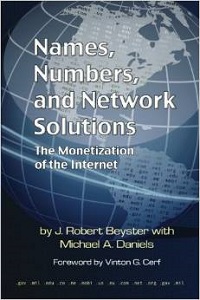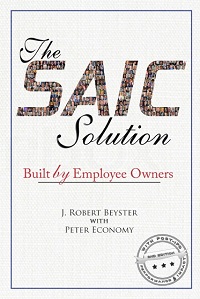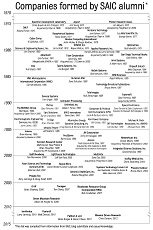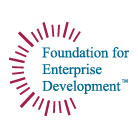Week twelve: San Diego Union-Tribune article
7 Comments Published by Dr. Beyster July 14th, 2006 in The Blog, The Book.Some of you may have noticed the article about my book and this blog in the Sunday (July 9, 2006) San Diego Union-Tribune newspaper. I appreciated the article and thought the reporter did a fine job capturing valid and relevant points. In case you haven’t seen the article (which is titled “Dr. Beyster’s Book”), you’ll find it here:
- Dr. Beyster’s Book (San Diego Union-Tribune)
Click on the comments link to share your thoughts.
Knowing where SAIC people have gone and what companies they have created is of real interest to me. I am pleased with your response to last week’s posting, and I have created it as a separate project area on the blog (towards the upper right corner of the home page) so that it remains a priority. I’d like to know more details on what these companies have accomplished — if you have a moment, please provide a sentence or two describing the company. The graphic will be updated periodically to incorporate your input and I hope to use the data in the book.- Bob
Here are comments on some of your responses:
Roger Webb (Week 1): At 82, it’s hard to realize that at one time I wasn’t such a bad racquetball player. I depended on regular racquetball and running in those days to keep me alert and burn off excess energy so I wasn’t impossible to get along with. Thanks for your comments on the old SAIC.
Jeff Smith (Week 2): There will be a systems integration discussion in the book. Of course, part of that will have to do with the networks that we used to build the capabilities. I may borrow the expression “From lab rats to big time systems integrators.”
Don Peat (Week 4): The LINAC group at G.A. grew from nothing to a very busy radiation services organization. I still keep a plan view of the complex of tunnels and service ports. It ran 24 hours a day, 7 days a week. It never could have happened without total dedication from a wide variety of users, engineers, and support people at G.A. Thanks for the memories.
Karen Roche (Week 6): Thank you for this excellent example of the difficulties the SAIC and Bellcore cultures had in working out a joint training program. Sounds like you were able to make that happen at least some of the time.
Steve Manning (Week 8): As you may recall, I was a big believer in combining and conducting both government and commercial business. Sometimes it worked, sometimes it didn’t. In both cases, success required an experienced team to win and, often, in the commercial arena, we were subcritical.
Greg Smith (Week 10): I still strongly believe that sales and marketing should be combined, although both functions are necessary. At SAIC, they were combined in my day. At Bellcore, they were not. There were difficulties in having the two organizations work together. The Bellcore marketing and sales activities were organized more traditionally, and I think this interfered with the flow of customer communications.
Dave Strobel (Week 11): Considering all the communications I’m getting from employees of Space Electronics, the company seems to have the old spirit.
Rick Valencia (Week 11): The Entrepreneur of the Year program is very important in recognizing local San Diego entrepreneurial talent. It’s been my honor to be a part of this program for many years, and I’m happy that the SAIC example motivated you.
Tsahi Gozani (Week 11): I hope we can include in the book some discussion of nondestructive testing as practiced at SAIC, Ancore, and other spin-offs. As you know, having worked in that field, I really wanted to make a big success out of those businesses.
Bud Pyatt (Week 11): I think your topic on the relationship between SAIC and S-Cubed is a good one, and I would be happy to try to work with you to get something included in the book.
Stanley Friesenhan (Week 11): That’s a tall order. If you will help me, I will try to get some more included on the LINAC, which I don’t feel I’m doing justice to right now.
Bob Burnett (Week 11): Thanks for the kind remarks on SAIC and me. I enjoyed my association with you very much over the years. It’s hard for me to believe SAIC was larger than TRW, but some people don’t know when to stop building. TRW was a model for me for so many years. I miss going to the SAG meetings in Omaha. Al Buckles tries to keep me informed. The depth and breadth of topics covered by the SAG really was mind boggling.
Jim Cramer (Week 11): Opinions are very polarized on the subject. There are those who didn’t think employee ownership made much of a difference, and there are those who think it did. And there are some who would differ with you and me about what it is. You may want to look at my July 13, 2006 comments to Babette Davis about the value of employee ownership. See if you agree.
Jake Lefman (Week 11): If one person builds a billion-dollar company after reading this book, then it will have been worth the effort.
Lyle Dunbar (Week 11): Good to hear from you. For years, I used to get very disturbed when a key person left SAIC and started his own company. Then finally I learned more was to be gained by working with those defectors where we could. At least we knew in most cases they built competent organizations.





Dr. Beyster: I am certainly not going to presume to offer any guidance on how your book should be crafted. I’m sure you will do your usual superb job at that; however, it has always been something of a wonder to me the way SAIC has successfully used our intricate system of working groups and committees to address issues and stay abreast of employee, business, and corporate concerns and needs. Bodies such as the TEC, the Ethics Committee, Stock Working Group, just to name a few, as well as the Division and Group Manager’s forums, all have a degree of cross-representation that truly allows items of import to be filtered to the proper levels of attention, generally accompanied by well considered recommendations or suggestions. Along the way, such topics get a thorough review and a variety of inputs, from numerous perspectives. To some degree, I believe this technique has contributed to the success of making us an excellent company to work for as well as positively impacting our bottom line. I would expect that you have a much better appreciation of the contributions made by this process than most, and if that is so, I would hope you consider addressing this in your book.
Best regards.
Bob – in 2003 someone asked me how I would describe SAIC. The following is how I responded. I am sure many others have said it better that I did.
Here is my earlier writeup:
My View of SAIC
William Grossmann
2003
Of the comparatively few times that something has been published about SAIC – mostly in the technical press, which makes sense given the “science“ in SAIC’s name – familiar business adjectives like entrepreneurial, flexible and non-hierarchical appear often. Yet perhaps the real secret to SAIC’s success is that its founder, Bob Beyster, based the company on the idea that one didn’t need large hierarchical structures in order to create a successful company. He figured that with tough guidelines on ethics (still one of industry’s most uncompromising) and little or no internal barriers to seeking business, a successful company could be created. Consciously or otherwise, he created an organization that has captured, in a unique way, the essence of American business (and perhaps being American): look for a problem to solve, dream up a good idea to fix it, find a customer, thrash out a decent relationship, solve the problem on-time and on-budget, document the results well – and go out armed with better knowledge and do the same thing again, but each time raising the bar of expertise. SAIC hasn’t changed much since it was founded, at least in the respect of the source of real power: the division level, first rung on the organizational ladder, is still where managers have complete responsibility for finding business (read, customers), developing it, hiring and firing, etc. There’s no corporate edict beyond that. In other words, SAIC employees are told they have complete freedom to develop any kind of business they want – as long as it meets ethical and profitability criteria. And oh, yes, SAIC makes it clear to everyone that they’re about being the absolute best in the world at finding solutions to problems, particularly technological ones.
SAIC is completely employee-owned. It now pulls in $6.1 billion in annual revenue, but few people within the company have made phenomenal amounts of money (Bob Beyster owns only 1.5% of the total stock of the firm). So what’s motivating these people – and what’ making them, year after year, so attractive to customers? Here’s one possible answer: SAIC is about giving the freedom to its people to figure out the best solution to their customer’s problem, utilize whatever intelligent systems they need to get the job done, with minimal corporate intervention. SAIC people think for themselves, and learn to sell their ideas for business solutions to their customer personally. And maybe customers like the idea that they’re dealing with a company which makes their ethics position so clear. But the result is intriguing. Americans are looked upon as being innovative, unhindered by historical precedents, enthusiastic and can-do oriented. Nothing describes SAIC better.
To Bill Grossman -
Many thanks for giving words to the reasons why it was harder for me to leave SAIC than any other move I have made – going away to college, leaving the government, leaving Washington D.C. after 20 years to move to Seattle, even closing the SAIC Russian business after 7 years of giving it every ounce of energy and effort I could muster. My Group Manager used to say: Gael, you can do anything at SAIC as long as it’s not illegal, unethical, or commits company financial resources — and you find a customer who believes you can solve his/her problem. What a quintessentially American idea – having freedom to innovate while honoring the rules of individual responsibility and responsibility to the best interests of the group.
Gael Tarleton
I worked at SAIC from 1997 to 2000.
My plan was simple. I bought every share I could. I worked hard so that I would always get the maximum annual increase and always have a charge number. And, I took advantage of every class or training opportunity that SAIC would fund. The best class was a CMM training class taught over several weeks by Elizabeth Comer – extremely bright and insightful.
The plan worked very well and I left to pursue other opportunities in 2000 after 3-1/2 years at SAIC. The stock treated me very well and I thoroughally enjoyed my time at the company.
The most valuable thing I took from SAIC was the CMM training that was provided to me. I utilize this methodology in virtually every complex project I tackle and have embraced it as my management model. It has infected other organizations as well. I now run a modest real estate investment business and benefit on a daily basis from my experiences at SAIC.
William Sheridan
President, SFinvest
Chico, CA
I’m pleased to see that you’re writing a book about the very interesting SAIC story.
In chapter 5, you might want to include some words about the retirement plans, which you asked me to develop early on, and how that led to employee ownership. Plan participants have done very well. Furthermore, the stock bonus plan (ESOP), which was not a well-known concept at the time, enabled employee ownership, insofar as it brought cash to the company and thereby ended the need for occasional stock sales to outside investors. At that time, you had the foresight to build an employee-owned company.
Later Gerry Pomraning’s (deceased) inventive creation of Bull, Inc. offered liquidity, which has facilitated employee ownership to this day.
As your first full-time employee, I want to thank you for providing the opportunity for an interesting job. When I joined SAI, I knew that it would be successful with you at its helm, but the company’s growth exceeded my imagination. As you promised when I was interviewed, it was fun.
Charlie Stevens
Thanks for posting such useful items. I’ve been reading his blog with much interest. He’s certainly raised my awareness. This post is Well Organized and Informative.
Senior Living San Diego: I’m glad you found my blog of use. We’re trying very hard to put in the blog anything happening to me of significance that might be of interest to others. — Bob